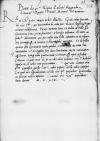Gratae nobis fuerunt cf. Ioannes DANTISCUS to Bona Sforza 1546-08-20 — 1546-09-20, CIDTC IDL 7474, letter lost⌊litteraecf. Ioannes DANTISCUS to Bona Sforza 1546-08-20 — 1546-09-20, CIDTC IDL 7474, letter lost⌋ Vestrae Paternitatis, quae nos tandem de certa pace Francis I of Valois (*1494 – †1547), 1515-1547 King of France; son of Charles, Count of Angoulême, and Louise of Savoy
Henry VIII Tudor (*1491 – †1547), 1509-1547 King of England; son of Henry VII Tudor and Elizabeth of York⌊Franciae Angliaeque regumFrancis I of Valois (*1494 – †1547), 1515-1547 King of France; son of Charles, Count of Angoulême, and Louise of Savoy
Henry VIII Tudor (*1491 – †1547), 1509-1547 King of England; son of Henry VII Tudor and Elizabeth of York⌋ certiores reddiderunt. Faxit Dominus Deus, ut itidem et bella haec Germanica bono exitu finiantur et haereses tollantur, et vires ac potentia Christianorum, quae per civilia ista bella atteritur et in viscera sua conversa est, in inimicos Christianae fidei vertatur.
Et de bellis quidem istis Germanicis multa quidem, verum falsa ac vana huc nuntiantur et in singulos fere dies commutantur iuxta varietatem affectuum, quisque enim partem suam victricem esse cupit et scribit. Ceterum, si quid certi de iis ac aliis rebus externis Vestra Paternitas habebit, significare id nobis non praetermittat.
Quae vero commisit Vestra Paternitas Stanisław Górski (*1489? – †1572), historian; since ca. 1535 started to gather the historical materials, called Acta Tomiciana (more correct Górski Files); since 1521 scribe in Piotr Tomicki's chancellery; since 1521 parish priest in Kunów; since ca. 1530-1535 - in Czeladź; 1530 notary public and scribe at the royal court; since 1533 parish priest in Mały Płock (near Kolno); 1534 Płock canon; since 1539 Cracow canon; since 1546 parish priest in Wiskitki (in Masovia); befor 1550 - in Modlinica (near Cracow)⌊Stanislao GorskiStanisław Górski (*1489? – †1572), historian; since ca. 1535 started to gather the historical materials, called Acta Tomiciana (more correct Górski Files); since 1521 scribe in Piotr Tomicki's chancellery; since 1521 parish priest in Kunów; since ca. 1530-1535 - in Czeladź; 1530 notary public and scribe at the royal court; since 1533 parish priest in Mały Płock (near Kolno); 1534 Płock canon; since 1539 Cracow canon; since 1546 parish priest in Wiskitki (in Masovia); befor 1550 - in Modlinica (near Cracow)⌋ canonico nobis referre, ea ille nobis exposuit. Cui quid nos responderimus, id ille Vestrae Paternitati perscribet.
Quam salvam paper damaged⌈[m]m paper damaged⌉ ac felicem valere optamus.


 BCz, 3465, p. 328
BCz, 3465, p. 328